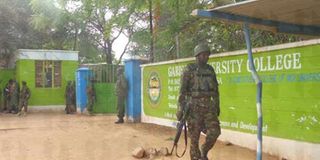Students leave Garissa University after Al-Shabaab kills over 147, injures 79

Police officers on guard at the entrance of Garissa University College on April 2, 2015 after armed gunmen attacked the institution. Students started leaving the university on April 3, 2015. PHOTO | ABDIMALIK HAJIR |
What you need to know:
- Students who spoke to Nation.co.ke said they would not return to the university while others said they would seek transfers.
- Top national and county leaders met on Thursday and agreed to suspend learning at the university until further notice to allow security agencies to investigate the attack.
- Ten NYS buses have been sent to the university to ferry the students home. Some come from as far as Busia in western Kenya.
- Garissa governor pleads with Kenyans not to desert the county after the attack.
Terrified students and members of staff of Garissa University College started leaving the campus on Friday, a day after Al-Shabaab killed 147 and injured 79 at the institution.
Students who spoke to Nation.co.ke said they would not return to the university while others said they would seek transfers.
"I can't come back here again. It is like risking my life to secure my future. I can't do that," said Pallete Okombo, a second-year student studying Education Arts.
"Some of my friends were killed. I was calling them, but they were not picking up. They were in the hostels. I had rented a house outside the university," he added.
Ten NYS buses have been sent to the university to ferry the students home. Some come from as far as Busia in western Kenya.
SUSPEND LEARNING
Top national and county leaders met on Thursday and agreed to suspend learning at the university until further notice to allow security agencies to investigate the attack.
Education Cabinet Secretary Joseph Kaimenyi, his PS Belio Kipsang, Garissa Town MP Aden Duale, Garissa Governor Nadhif Jama, his deputy Abdulahi Hussein, Inspector-General of Police Joseph Boinnet and Interior CS Joseph Nkaissery attended the meeting.
Mr Jama, the governor, pleaded with Kenyans not to desert the county after the attack.
“We must condemn this heinous attack perpetrated by those who love to divide Kenyans. Garissa County would like to assure everyone that it will work with the national government to deal with them,” he told reporters in Garissa Town.
COLLECT BODIES
On Friday, emergency workers continued to collect the bodies of those killed in the siege that lasted 10 hours.
The official death toll is 147, but the workers said they had counted more bodies than the number given by the Interior ministry.
On Thursday night, Mr Nkaissery announced the siege was over.
Mr Boinnet imposed a dusk-to-dawn curfew beginning on Friday until April 16.
The IG argued the move was because of “elevated threat or terror and security operations”.
He extended it to Wajir, Mandera and Tana River counties.
RESIDENTS IN FEAR
But even before the curfew could kick off, residents had imposed one on themselves.
They kept away from public places, except for crowds that gathered near the university.
Most shops, banks, supermarkets, eateries and other public places remained closed on Thursday.
Some said they feared the government could crack down on suspects, roughing up innocent civilians in the operation.
“I can’t go near them. I fear them. They are very harsh when annoyed, those KDFs,” said Ali Hussein, a cobbler in Garissa.
On Friday, business went on, with most shops opening in the town.





